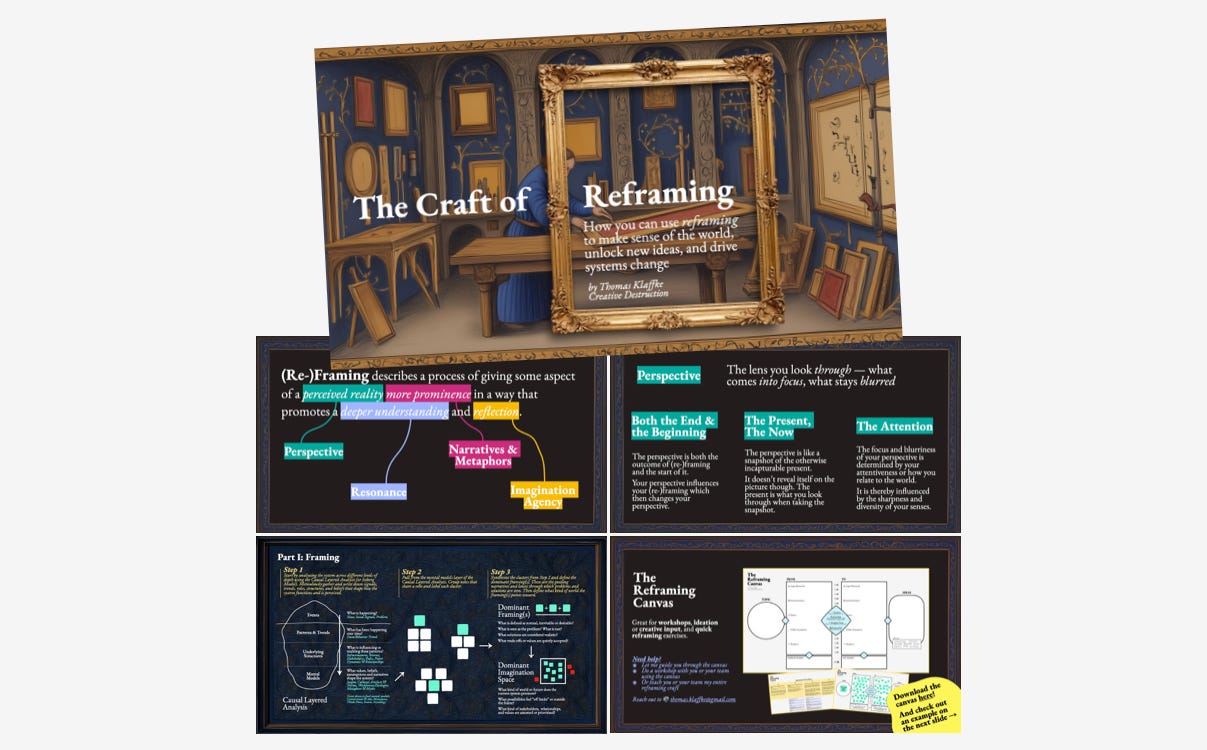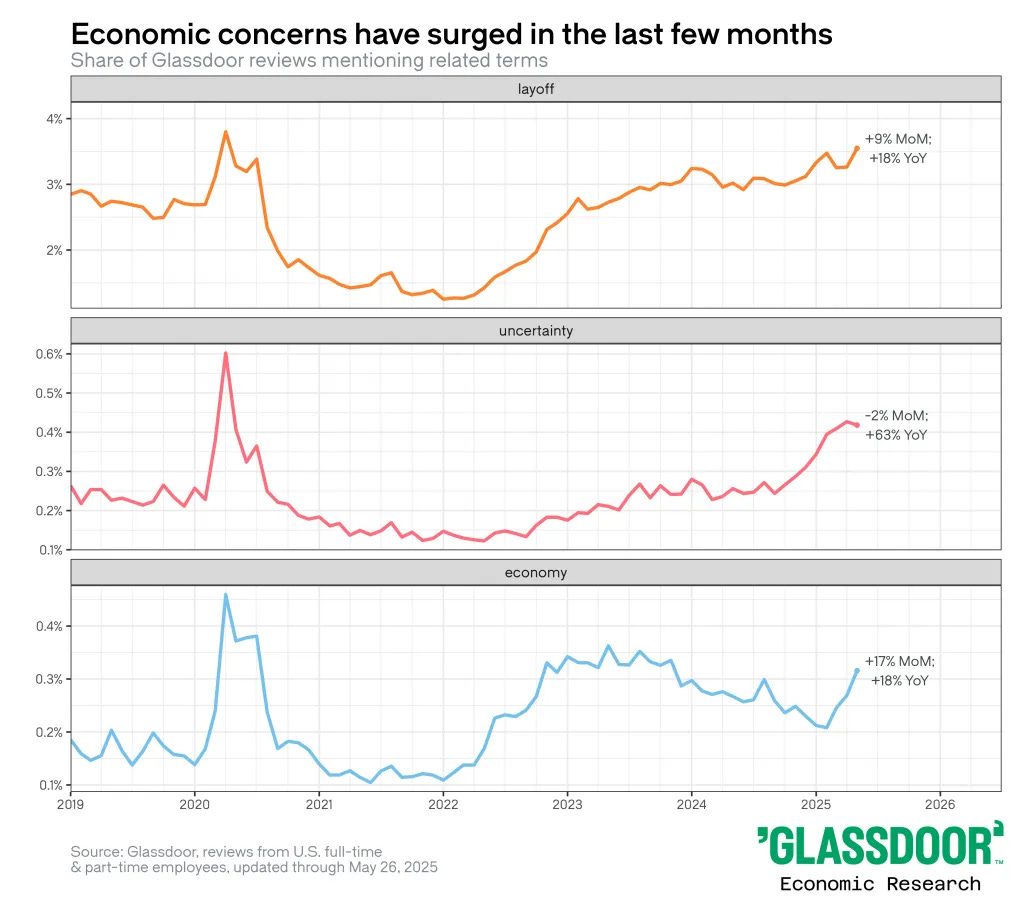Rabbit Holes 🕳️ #120
From hypernormalization to watching millionaires, electrostates, the wisdom economy, is it worth making?, migration as a rhythm, artists corporations, self-build housing, and an overtourism index
Hello and welcome to the 41 new subscribers who joined us since last week.
Again, in the rare case that you missed it, have a look at my latest deep dive: The Craft of Reframing — an in-depth introduction to my reframing philosophy, technique (including a comprehensive step-by-step guide + a very actionable Reframing Canvas), and aesthetic. And please do reach out if you want me to explain this method to you or your team!
And now onto this week’s Rabbit Holes:
THIS WEEK ↓
🖼️ Framings: Hypernormalization // Watching Millionaires // Electrostates
📊 Numbers: 2020-Level Uncertainty
🌀 Re-Framings: Knowledge Economy → Wisdom Economy // Can It Be Made? → Is It Worth Making? // Migration Is Not A Crisis, But A Rhythm
🧬 Frameworks: Artist Corporations
🎨 Works: Low-Tech Insulation // Self-Build Housing // Overtourism Index
⏳ Reading Time: 10 minutes“In taming the world, we have tamed ourselves.”
Erik Rittenberry
🖼️ Framings
Naming Framing it! Giving something we all feel more prominence in a way that promotes a deeper reflection.
😒 Hypernormalization
Very interesting framing that relates to the concept of “sanewashing”, the famous “this is fine” meme, and my article The Growing Desire For Radical Change, from November last year. In the piece below, I especially like the last bit about people not shutting down because they don’t feel anything, but because they feel too much.
“Hypernormalization” is a heady, $10 word, but it captures the weird, dire atmosphere of the US in 2025.
First articulated in 2005 by scholar Alexei Yurchak to describe the civilian experience in Soviet Russia, hypernormalization describes life in a society where two main things are happening.
The first is people seeing that governing systems and institutions are broken. And the second is that, for reasons including a lack of effective leadership and an inability to imagine how to disrupt the status quo, people carry on with their lives as normal despite systemic dysfunction – give or take a heavy load of fear, dread, denial and dissociation. […]
Hypernormalization captures this juxtaposition of the dysfunctional and mundane. […]
Confronting systemic collapse can be so disorienting, overwhelming and even humiliating, that many tune it out or find themselves in a state of freeze. Greguski likens this feeling to sleep paralysis: “basically a waking nightmare where you’re like: ‘I’m here, I’m aware, but I’m so scared and I can’t move.’” […]
“People don’t shut down because they don’t feel anything,” says Hickman. “They shut down because they feel too much.” Understanding this overwhelm is an important first step in resisting inaction – it helps us see fear as a trap.”
» Systems are crumbling – but daily life continues. The dissonance is real by Adrienne Matei
🤑 Watching Millionaires
Another interesting framing about our cultural obsession with millionaires and its opportunity costs (meaning that we miss more relating stories of ordinary people, i.e. 99.9% of people). I had a similar thought recently when a friend posted yet another Elon Musk story in our friends group… I know more about this guy’s life by now than about the bird that just visited my balcony…
“I watched the Champions League final the other day when it struck me: I’m basically watching millionaires all the time. The players are millionaires, the coaches are millionaires, the club owners are millionaires. It’s surreal.
This week I watched John Wick Ballerina and, again, there’s Keanu Reeves, who is a millionaire, and Ana de Armas, who is as well. Yesterday I heard about Trump and Musk fighting. They are not millionaires, they are billionaires! As I’m writing this, I’m watching the Rock am Ring live stream, a music festival in Germany. Weezer is playing. These guys are all millionaires.
I don’t know what to make of it. It’s a strange realization, but one that feels worth sharing. I could go down the road of how this fixation on elites distracts us from the people nearby, but that’s not quite it. What interests me more is how normalized this has become.
Maybe it’s just the power law in action: a few rise to the top, and we amplify them by watching. But most people in every field aren’t millionaires. We just don’t see them.”
» Watching Millionaires by Matthias Endler
⚡ Electrostates
We’re moving from petrostates to electrostates, with China being the world’s first one. Lots of major implications tied to that, such as China’s increased self-sufficiency and being at the forefront of renewable technologies (despite still being the world’s biggest greenhouse gas producer, accounting for 80% of coal-fired power under construction globally, and being a genuine dictatorship…of course 😅). However, I do wonder how other countries might respond. Will they also want to become electrostates, or perhaps create alternative goals for themselves? I’d propose carestates, biostates, creatorstates, commonsstates, and fullofbeautystates…
“China is on its way to becoming the world’s first “electrostate”, with a growing share of its energy coming from electricity and an economy increasingly driven by clean technologies. It offers China a strategic buffer from trade decoupling and rising geopolitical tensions with the US.
The country is not only rapidly advancing towards self-sufficiency in energy from secure domestic sources, but also wields vast power over the markets for the resources and materials that underpin technologies of the future. […]
Earlier industrial revolutions were led first by the UK and then by the US, including the so-called information age more recently. But it is China that now leads the latest global technology revolution in electrification and renewable energy, say analysts from US-based energy think-tank RMI and other independent research groups. And just as oil and gas drive a petrostate’s economy, clean energy technologies are making a significant contribution to Chinese growth. […]
Supported by […] long-term state investments in the power grid, China is on course to source 50 per cent of its power from low-carbon energy including hydro, solar, wind, nuclear and battery storage systems by 2028. About 10 years later combined solar and wind capacity are on track to reach a historic inflection point, exceeding coal-fired power generation for the first time.”
» How Xi sparked China’s electricity revolution by Nassos Stylianou, Jana Tauschinski & Edward White
📈 Numbers
A thought-provoking chart that perfectly captures a pivotal shift:
🤷♂️ 2020-Level Uncertainty
Below the paywall: This is the part in which I share reframings and unconventional ideas that make you see and build another world – a more regenerative, caring, and joyful world. Join my now over 180 paid subscribers by upgrading to get access:





